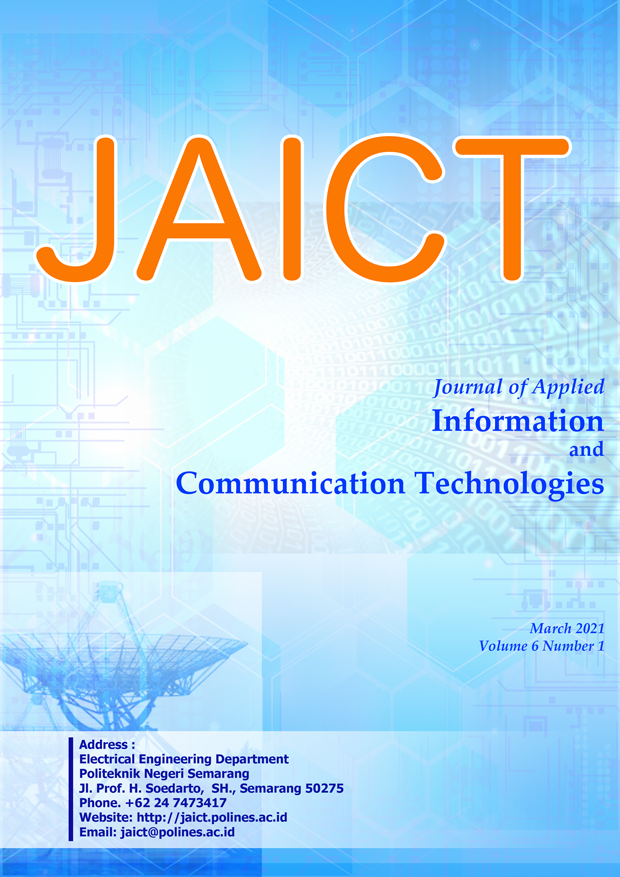Classification of Covid-19 Survillance Datasets using the Decision Tree Algorithm
DOI:
https://doi.org/10.32497/jaict.v6i1.2896Keywords:
Decision tree, covid-19 surveillance, accuracyAbstract
Covid-19 is a new type of mutated virus that has been discovered and studied throughout the world. For the time being, no effective drug has been found to treat or prevent this disease. One way that governments around the world are doing is limiting physical contact with people with COVID-19. Data mining is a computer science to study data and perform extraction to get new knowledge. One technique in data mining is classification. C45 is one of the best classification algorithms. The result of the c45 algorithm can be a decision tree. Decision trees are used because the results can be well represented. and can be easily understood in human language. This study classified the Covid-19 surveillance dataset using the Decission tree. The Covid-19 surveillance dataset was obtained from a public data portal, namely the UCI machine learning repository. This study resulted in better accuracy than previous studies using the same dataset. The level of accuracy obtained by using the decision tree algorithm is 65%. Although in this study the accuracy value has increased by 10%, the level of accuracy is still relatively low. The low level of accuracy is due to the dataset used only has 7 attributes and 14 recordsReferences
I. H. Witten, E. Frank, and M. A. Hall, Data Mining: Practical Machine Learning Tools and Techniques 3rd Edition. Elsevier, 2011.
X. Wu et al., Top 10 algorithms in data mining, vol. 14, no. 1. 2007.
M. A. Alkaromi, “Information Gain untuk Pemilihan Fitur pada Klasifikasi Heregistrasi Calon Mahasiswa dengan Menggunakan K-NN,” 2014.
Ivandari and M. A. Al Karomi, “Algoritma K-NN untuk klasifikasi dataset Covid-19 survillance,” IC Tech, vol. 16, no. 1, pp. 12”“15, 2021, [Online]. Available: https://ejournal.stmik-wp.ac.id/index.php/ictech/article/view/137.
D. T. Larose, Discovering Knowledge in Data. John Wiley & Sons, 2005.
E. Prasetyo, Data Mining Konsep dan Aplikasi menggunakan Matlab. Yogyakarta: Andi Offset, 2012.
B. Santosa, Data Mining Teknik Pemanfaatan Data untuk Keperluan Bisnis, Edisi Pert. Yogyakarta: Graha Ilmu, 2007.
A. Christobel and D. . Sivaprakasam, “An Empirical Comparison of Data Mining Classification Methods,” vol. 3, no. 2, pp. 24”“28, 2011.
A. H. M. Ragab, A. Y. Noaman, A. S. Al-Ghamdi, and A. I. Madbouly, “A Comparative Analysis of Classification Algorithms for Students College Enrollment Approval Using Data Mining,” Proc. 2014 Work. Interact. Des. Educ. Environ. - IDEE ”™14, pp. 106”“113, 2014, doi: 10.1145/2643604.2643631.
A. Ashari, I. Paryudi, and A. M. Tjoa, “Performance Comparison between Naïve Bayes , Decision Tree and k-Nearest Neighbor in Searching Alternative Design in an Energy Simulation Tool,” vol. 4, no. 11, pp. 33”“39, 2013.
S. Susanto and D. Suryadi, Pengantar Data Mining: Menggali Pengetahuan dari Bongkahan Data. Yogyakarta: Andi Offset, 2010.
D. R. Amancio et al., “A systematic comparison of supervised classifiers,” Oct. 2013, Accessed: Oct. 20, 2014. [Online]. Available: http://arxiv.org/abs/1311.0202v1.
J. Han and M. Kamber, Data Mining: Concepts and Techniques Second Edition. Elsevier, 2006.
D. Widiastuti, J. S. Informasi, and U. Gunadarma, “ANALISA PERBANDINGAN ALGORITMA SVM , NAIVE BAYES , DAN DECISION TREE DALAM MENGKLASIFIKASIKAN SERANGAN ( ATTACKS ),” pp. 1”“8, 2007.
Kusrini and L. E. Taufiq, Algoritma Data Mining. Yogyakarta: Andi Offset, 2009.
F. Gorunescu, Data Mining: Concept, Models and Techniques, Vol 12. Berlin: Heidelberg: Springer Berlin Heidelberg, 2011.
M. A. Alkaromi, “Komparasi Algoritma Klasifikasi untuk dataset iris dengan rapid miner,” IC Tech, vol. XI, no. 2, 2014.
I. Indrayanti, S. Devi, and M. A. Al Karomi, “Peningkatan Akurasi Algoritma KNN dengan Seleksi Fitur Gain Ratio untuk Klasifikasi Penyakit Diabetes Mellitus,” IC-TECH, vol. XIII, no. 2, pp. 1”“6, 2017.
Downloads
Additional Files
Published
Issue
Section
License
Authors who publish with this journal agree to the following terms:Authors retain copyright and grant the journal right of first publication with the work simultaneously licensed under a Creative Commons Attribution License that allows others to share the work with an acknowledgement of the work's authorship and initial publication in this journal.
Authors are able to enter into separate, additional contractual arrangements for the non-exclusive distribution of the journal's published version of the work (e.g., post it to an institutional repository or publish it in a book), with an acknowledgement of its initial publication in this journal.
Authors are permitted and encouraged to post their work online (e.g., in institutional repositories or on their website) prior to and during the submission process, as it can lead to productive exchanges, as well as earlier and greater citation of published work (See The Effect of Open Access).






